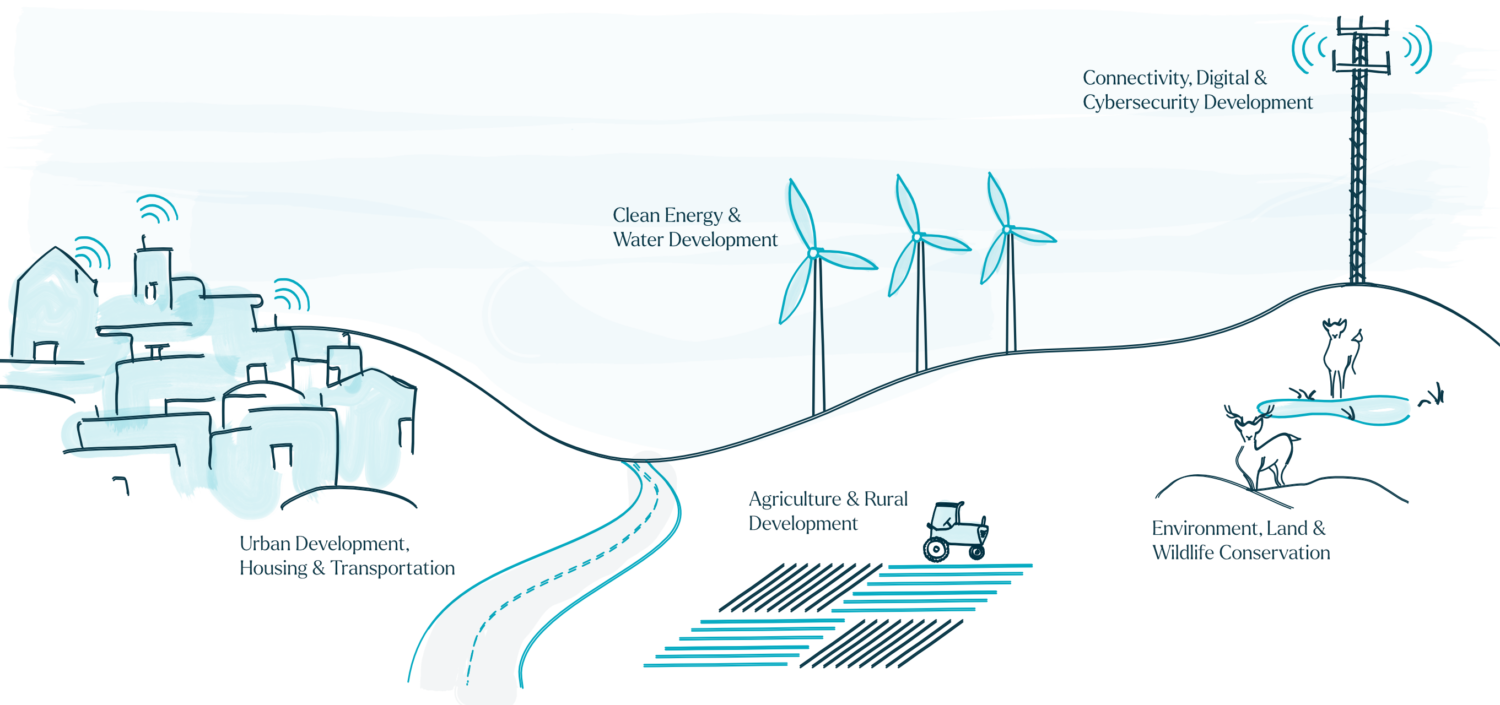Improving Infrastructure to Impact Generations
The 2021 Infrastructure Investments & Jobs Act is a tremendous opportunity for Tribal Nations to address community needs and build Tribal economies for the next generations. In this article, I want to focus on not just the dollars involved but how Tribal Leaders should be thinking about this funding and the best approach to utilizing it. Here are my key takeaways as we consider the Infrastructure Act:
Infrastructure Act Key Take-Aways
- Physical infrastructure is the backbone of a strong Tribal economy & a healthy Tribal community
- Investing in infrastructure can stimulate your Tribal economy, meet current community needs, create job opportunities for Tribal members, and build capacity for the future growth of your Nation
- By leveraging the full potential of ARPA, the Infrastructure Bill, & other program dollars, there is a once-in-a-lifetime opportunity to address infrastructure needs in your community
- In the current economic climate, construction projects are risky. Implementing a government-wide structured planning can help mitigate these risks
$15 Billion for Water, Clean Energy, Broadband, and more…
Roads, bridges, water, power, broadband—these are the foundational items for building a thriving economy and a healthy community. While not always given the focus in conversations of economic development, physical infrastructure enables businesses to grow and individuals to capture opportunities. Whether service-based or product-based, physical infrastructure connects businesses with consumers, allows for efficient movement of goods, and connection with the supply chain.

The Infastrucure Act’s $15 Billion to Tribes covers a wide range of phyiscal infastrucre that will have a direct impact on your Tribe’s quality of life and economy.
See the funding details of the 2021 Infrastructure Investment and Jobs Act.
Infrastructure = Economic Impact
Short Term: Increased Job Opportunities
In the short term, investing in infrastructure can increase job opportunities and financially stimulate the Tribal economy, all while meeting the immediate needs of the community. Infrastructure development creates jobs through building and maintenance, and connecting your Tribal members to these opportunities through education and workforce development programs can create jobs on the reservation. It is estimated that 11% of all U.S. jobs are directly connected to physical infrastructure. Working with your Tribe’s job training programs, or establishing relationships with nearby programs or trade schools, can help prepare members to capture the opportunities created through infrastructure investment.
Long Term: Future Economic & Community Development
In the long term, increased infrastructure will build the capacity for further economic and community development, as well as increased quality of life and opportunity for membership. On the economic side, strong infrastructure allows for an increased number of businesses—whether Tribally-owned or by membership entrepreneurs—and more potential for new types of businesses. Examples may be increased agricultural production or manufacturing exports. For the community side, infrastructure allows for increased development of community facilities and housing, and cleaner power, water, and wastewater running to these buildings.
The most important aspect of the Tribal economy is the people: your Tribal members. Quality physical infrastructure is essential to the health of a Tribal population. Roads, bridges, and power are key to public safety. Clean water and wastewater treatment are essential for public health. Broadband and communications connect individuals to economic opportunity and can boost public safety and public health capacity.
Taking The Next Steps
As you think about creating a strategy for leveraging the Infrastructure Bill dollars keep these principles in mind.
Principle 1. Leverage Restrictive “Program” Dollars First
Every Tribe has received funding from ARPA direct payments, but through a well-defined strategy, there is an opportunity to greatly increase the funding opportunity available in the coming years. The greatest opportunity to maximize funds is in directing efforts to compete for restrictive program dollars before spending direct ARPA allocations or Tribal funds. Many of the dollars allocated through the Infrastructure Bill, and non-direct ARPA funds, will be administered through competitive and highly regulated programs, requiring you to spend them on specific uses. Leverage these dollars to address as many needs as possible before spending direct ARPA dollars and Tribal funds.
Principle 2. Take the Time to Plan Now
In order to maximize the impact of this funding opportunity, start developing a funding strategy to meet community needs. The rushed timeline of CARES funds is behind us. There are still two years left to allocate ARPA (four years to expend), and the Infrastructure Bill funds will be distributed annually over the next five years. This leaves time to take the necessary steps for a quality plan.
In order to develop this strategy, consider taking the following steps:

Establish Community Goals at the Council Level
Establish Tribal goals from the leadership level to ensure all governmental efforts are directed towards the vision of Council.

Prioritize & Plan Projects to Meet Council Goals
Plan & prioritize projects from the departmental level that fulfill the goals set by Council.

Complete & Missing Foundational Documents
Complete the necessary foundational planning documents, for example:
- Land Use Plan
- Broadband Plan
- 5-Year Housing Plan
- IHS Critical
- Water List
- Transportation Improvement Plan

Establish Relationships with the Regional Offices for Key Federal Agencies
To maximize competitiveness, reach out to regional representatives for key funding agencies (USDA, EDA, NTIA, etc.) about their programs & your projects.
In addition to increasing your Tribe’s funding opportunity, implementing a structured planning process, with priorities set from the Council level, will give your Tribe a number of advantages in seeking funds and implementing projects: identification & development of capacity needs, careful tracking for reporting requirements, protection from haphazardly planned projects.
With current issues in the supply chain, workforce gaps, and inflation, it is a risky time to be investing in construction projects. Careful, structured, and consistent planning throughout your governmental organization is the best way to mitigate this risk.
Lessons from Case Studies
In the last few years, we have partnered with several Tribes on infrastructure and large projects and their experience is beneficial when considering how you will be approaching the use of the Infrastructure Act.
Proactive Planning to Make a Significant Impact
Located off of a major rural highway, a Tribe had a number of dangerous turn-ins, one to the community and one into the Tribal gas station. The hazardous turn-ins likely decreased traffic flow to their gas pumps and threatened the safety of community members. By using ARPA dollars to complete engineering planning around their road projects, they have a prioritized road projects pipeline to seek Infrastructure Bill dollars over the next five years.
Lesson: Proactive planning on basic infrastructure projects can make a lasting impact on Tribal businesses, community safety and future economic development opportunities.
Planning Early Brought Additional Funding
A Tribal Nation was allocated $100 million dollars through ARPA-direct payments. Through a survey of potential projects for spending, it was estimated that needs totaled up to $200 million dollars—twice as much as their federal allocation. The Tribe implemented a structured planning program to ensure all potential ARPA expenditures sought alternative funding first. In less than a year of allocation, they were able to increase their original recovery funding by 25%.
Lesson: By implementing structured planning processes, more projects can be prepared to seek outside grant opportunities, and they will be more competitive in winning these grants.
Careful Planning and Focusing on Details is Essential
A Tribal Council was holding a meeting to consider the approval of a development project. The government did not have strict requirements in place for planning construction projects, and nearly 90-days had passed since the original cost estimates. During the presentation, the contractor interjected noting that costs had increased by 50% and the projects would take another year from the original timeline. Had the Council approved the project, it would have been far off-budget and behind schedule. There may not have been enough funds to complete the project.
Lesson: Due to supply chain and other issues, the current economic climate is risky for construction projects. Careful planning is the only way to mitigate these risks.
Make a Great Impact
Infrastructure is the foundational framework for a healthy economy and healthy people, and investing in infrastructure not only builds for future development but can create opportunity now. Working to ensure that the investments in your community also creates opportunities for your Tribal members is the path towards holistic development.
Take the time to develop a strategy for these funds, make the greatest impact on your community, and protect the future of your Nation.
